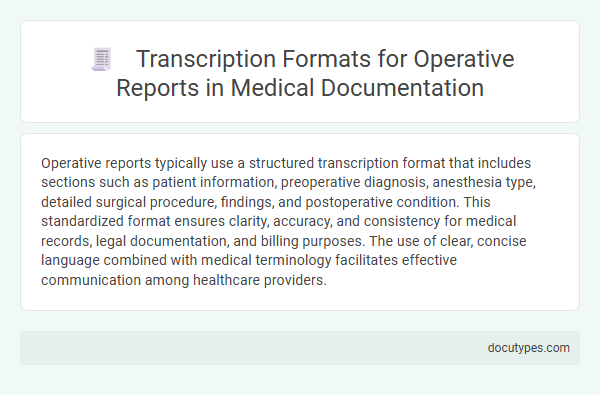Operative reports typically use a structured transcription format that includes sections such as patient information, preoperative diagnosis, anesthesia type, detailed surgical procedure, findings, and postoperative condition. This standardized format ensures clarity, accuracy, and consistency for medical records, legal documentation, and billing purposes. The use of clear, concise language combined with medical terminology facilitates effective communication among healthcare providers.
Introduction to Operative Report Transcription
Operative report transcription is a critical component of medical documentation that details surgical procedures performed on a patient. This transcription ensures accurate and comprehensive records for clinical, legal, and billing purposes.
The standard format for operative report transcription typically includes patient information, preoperative diagnosis, procedural details, and postoperative instructions. Clear, structured transcription enhances communication among healthcare providers and supports optimal patient care outcomes.
Importance of Standardized Transcription Formats
Operative reports utilize standardized transcription formats to ensure clarity and consistency in documenting surgical procedures. These formats follow specific structures that capture critical details such as patient information, surgical techniques, and postoperative instructions.
Standardized transcription formats enhance communication between surgical teams, radiologists, and billing departments by providing uniform documentation. This consistency aids in accurate medical record-keeping, facilitates insurance claims processing, and supports legal compliance. Adherence to recognized formats like SOAP or dictation-based templates improves data extraction for research and quality improvement initiatives.
Key Sections in Operative Report Documentation
Operative reports typically use a structured transcription format to ensure clarity and completeness in surgical documentation. Key sections in operative report documentation include the preoperative diagnosis, procedure performed, surgeon's findings, and postoperative instructions. These sections provide essential details to support patient care continuity, legal documentation, and medical billing processes.
Narrative Versus Structured Formats
Operative reports use various transcription formats to document surgical procedures, mainly divided into narrative and structured formats. Understanding the differences helps improve accuracy and clarity in your medical records.
- Narrative Format - This traditional method allows free-text entry, providing a detailed, descriptive account of the surgery.
- Structured Format - Utilizes predefined templates and data fields to standardize information and enhance data extraction.
- Clinical Efficiency - Structured formats improve consistency and facilitate electronic health record integration, whereas narrative formats offer flexibility for complex cases.
Choosing the appropriate transcription format depends on clinical context and documentation requirements to ensure comprehensive operative reporting.
Essential Data Fields in Operative Reports
Operative reports use a structured transcription format to ensure clear communication of surgical details. Accurate documentation of essential data fields supports patient safety and legal compliance.
- Patient Identification - Includes the patient's full name, medical record number, and date of birth for precise record matching.
- Procedure Description - Details the specific surgical techniques and steps performed during the operation.
- Surgical Findings - Documents observations made during the procedure that impact diagnosis and treatment decisions.
- Surgeon's Name and Credentials - Identifies the operating surgeon for accountability and follow-up purposes.
- Anesthesia Details - Records the type and administration of anesthesia to monitor patient safety.
- Specimen Information - Notes any tissue or samples removed, including labeling for pathology.
- Complications and Outcomes - Describes any intraoperative issues and the immediate surgical result to inform postoperative care.
Best Practices for Formatting Operative Transcripts
Operative reports use a structured transcription format to ensure clarity and completeness. This format typically includes sections such as preoperative diagnosis, procedure performed, surgeon details, anesthesia type, findings, and postoperative instructions.
Best practices for formatting operative transcripts emphasize accuracy, legibility, and chronological order. Your documentation should follow established templates and include precise medical terminology to support efficient communication and legal compliance.
Compliance with Regulatory Guidelines
| Aspect | Details |
|---|---|
| Transcription Format | Operative reports are typically transcribed using a structured format that includes sections such as Patient Identification, Preoperative Diagnosis, Procedure Performed, Surgeon's Notes, Findings, and Postoperative Instructions. This structure ensures clarity and completeness. |
| Compliance with Regulatory Guidelines | Transcription formats must adhere to standards set by HIPAA (Health Insurance Portability and Accountability Act), ensuring patient confidentiality and data security. Additionally, adherence to guidelines from The Joint Commission and Centers for Medicare & Medicaid Services (CMS) is critical for documentation accuracy, completeness, and timely submission. |
| HIPAA Compliance | Use of secure transcription platforms with encryption and access controls protects your patient information during the transcription process. Proper authorization and verification protocols are mandatory before transcription begins. |
| Accuracy and Legibility | Operative reports require precise medical terminology and standardized abbreviations to avoid ambiguity. Transcriptionists must be trained in relevant medical specialties to maintain accuracy and compliance. |
| Timeliness | Regulatory guidelines stipulate that operative reports are transcribed and available within a specific timeframe to support clinical decision-making and billing processes. |
| Audit and Quality Control | Regular audits and quality checks ensure that the transcription process complies with regulatory requirements and institutional policies. This includes accuracy verification and confirmation of consent documentation. |
Role of Technology in Operative Report Transcription
What transcription format is commonly used for operative reports in modern medical practice?
Operative reports typically utilize structured formats such as SOAP (Subjective, Objective, Assessment, Plan) or predefined templates to ensure clarity and consistency. Advanced speech recognition technology and electronic health record (EHR) integration enhance the accuracy and efficiency of transcription processes in surgical documentation.
Common Challenges in Formatting Operative Reports
The transcription format for operative reports often follows a structured template to ensure all critical surgical details are documented clearly. Common challenges in formatting operative reports include maintaining consistency, accuracy, and clarity throughout the narration.
- Inconsistent Terminology - Variations in medical language can lead to confusion and misinterpretation of surgical details.
- Incomplete Documentation - Omissions of key procedural steps or patient data may compromise the report's usefulness for postoperative care.
- Poor Organization - Disorganized report structure hinders quick retrieval of important information during clinical decision-making.
What Transcription Format Is Used for Operative Reports? Infographic

